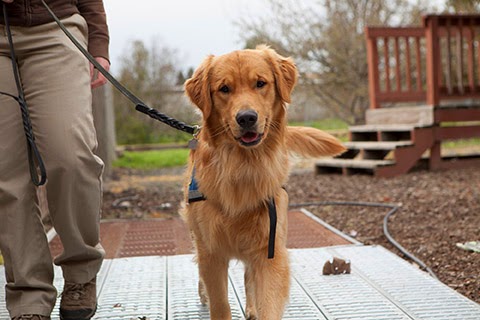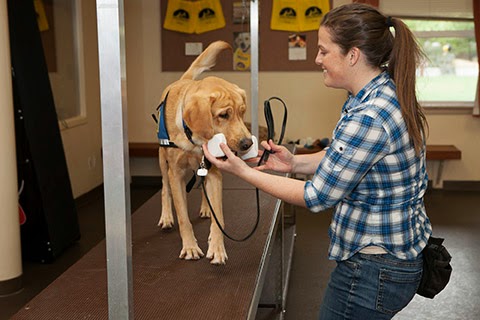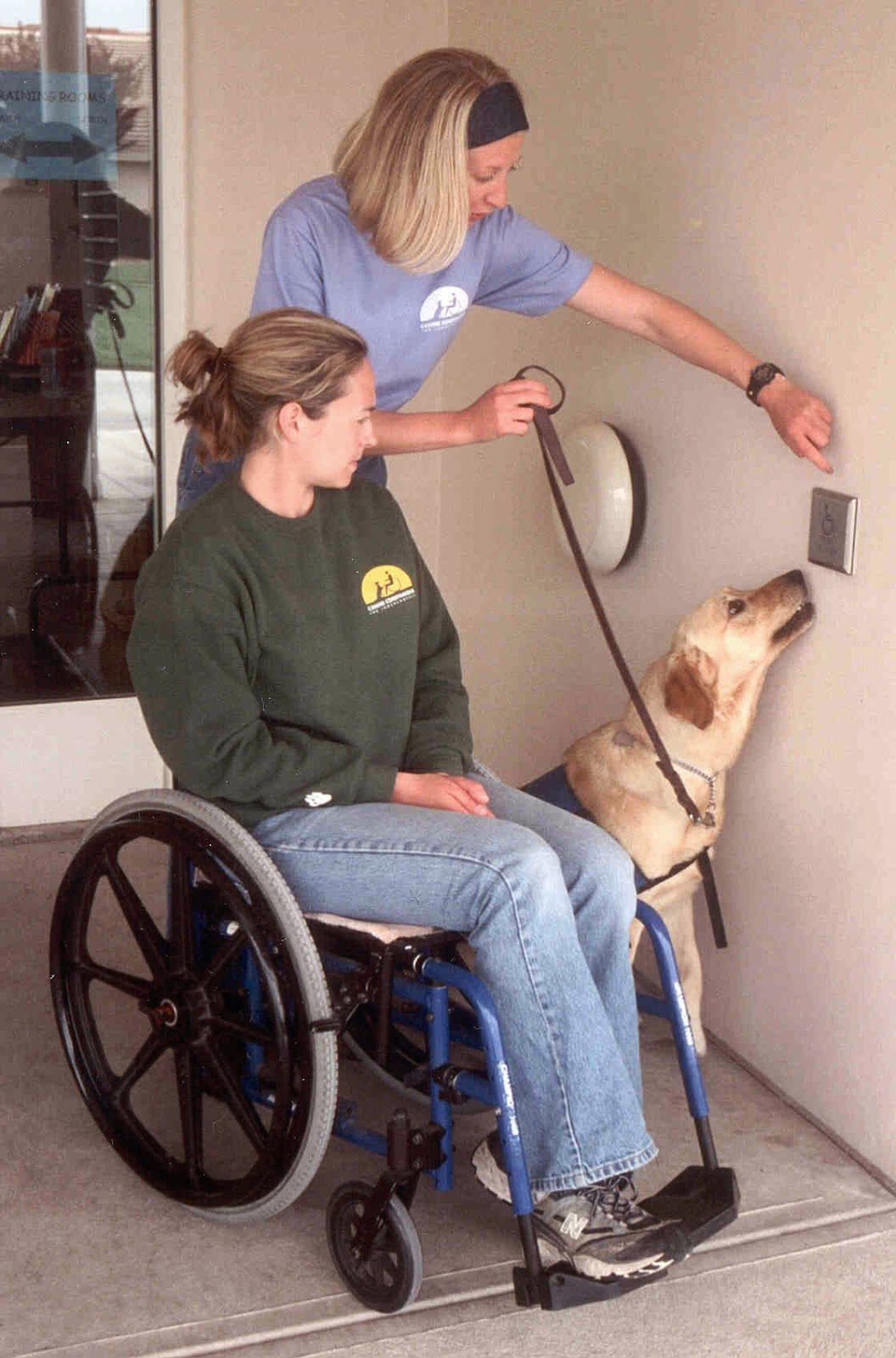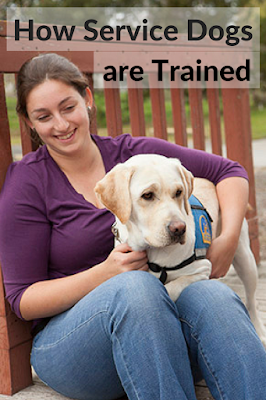This month, the Positive Pet Training Blog Hop (hosted by Cascadian Nomads, Dachshund Nola and Tenacious Little Terrier) is celebrating International Assistance Dog Week. Canine Companions for Independence (they train service dogs, skilled companion dogs, facility dogs and hearing dogs) answered some questions I had about the training their dogs undergo.
.jpg) |
| Courtesy of Canine Companions for Independence |
1. Which methods of training do you use? And why?
Canine Companions uses a variety of training methods depending on the task that is being trained. Our training structure is based on 35 years of experience and fine tuning how dogs learn each command the best. Many of our commands are taught using a food and clicker while others are taught by modeling or shaping from current behaviors.
2. What are the dogs' daily routine like once they are in training?
The dogs spend most of their day with their trainer in our training building. They will be either crated or on tethers during this time. The trainer works individually with each dog multiple times throughout the day depending on what semester of training they are in. They are also fed twice a day and given the opportunity to play in large groups in our community run yards (both concrete and grass). Some days the dogs go on public outings with their trainers to work on public access.
.jpg) |
| Courtesy of Canine Companions for Independence |
3. What does it take to be a Canine Companions assistance dog? How many make the cut?
It does a very solid temperament, good health, a willingness to work, and a desire to please to become a Canine Companions assistance dog. All of our dogs are wonderful but we do look for dogs that are not only good at the work but that also enjoy it! Right now about 40% of our dogs graduate to become assistance dogs.
4. How is it determined which kind of assistance work the dogs end up doing? How are the dogs matched to the work?
The type of work a dog ends up doing really is fitted to their strengths and temperament styles. Dogs that are particularly strong in their interactions with children may end up becoming a skilled companion for a child or a facility dog for a special ed teacher. Dogs who’s strength is really in their working skills may become a service dog for a disabled individual. Our hearing dogs tend to be dogs that are very alert and aware of their environment and self-initiators.
5. Do the trainers train to prevent separation anxiety in the dogs? Or is that not a big concern with service dogs? Especially in the prison program where I assume they would be around people all day.
Separation anxiety is not something we generally see with our dogs. They spend most of their lives accompanying their person on all outings. That being said, we do ask that all of our dogs also be familiar and comfortable spending time home alone in their crate and also spending time crated when there are people home. Because we highlight this from a young age, our dogs tend to be well socialized and comfortable in public and home alone.
6. Which unusual commands do the dogs learn?
Our dogs learn a variety of things besides basic obedience. This includes pulling a wheelchair, tugging doors/drawers/clothing, turning lights on and off, pushing automatic door buttons or drawers, and alerting to someone calling the handlers name to describe a few.
.jpg) |
| Courtesy of Canine Companions for Independence |
7. How do you train intelligent disobedience in the dogs?
We look for dogs that are already showing an aptitude for this in training. With our hearing dogs this is an important factor in their work. We train it with a lot of repetition and high value rewarding for when the dog breaks a command or behavior to do their task.
8. During team training, what do the handlers learn about working with their dogs?
Our handlers go through an intensive two week training course where they learn the following: canine health and care, canine communication, motivation & resistance, Canine learning theory, Canine daily routines, Do’s and Don’t of public access, as well as having many practical one on one and group handling sessions both at our center and in public.
Our next hop is September 1. Any posts about positive pet training are welcome.




Interesting questions and answers! Thanks for sharing with us!
ReplyDeleteLots of love,
My Dog Diaries
www.mydogdiaries1.blogspot.com
Thanks so much for joining the hop. :) That is very interesting. I wish she had explained what intelligent disobedience is more. Bet brown dawgs would be good at that...lol.
ReplyDeleteI love all the dedication that goes into training these awesome dogs. And considering that not all dogs pass (as you mention 40% in your program) it goes to show how serious you are about providing the right dogs with the right people.
ReplyDeleteI really enjoyed reading this! Very interesting!
ReplyDeleteOne of my relatives had a puppy training program at her college. I was hoping she would join, but she wanted to study abroad and the two things weren't compatible. I know it is a huge commitment, but it is so beneficial to the people the dogs ultimately help.
ReplyDeleteThanks for sharing
ReplyDeleteWhat a great look into how CCI does their training. I've been a fan of the program for years.
ReplyDeleteI really enjoyed reading your interview, great job!
ReplyDeleteAssistance and service dogs are so awesome, my friend trains them as well, just love reading about the wonderful work they do.
Assistant dogs have always amazed me. They are so talented! The people who train them must have the patience of a saint. It is cool to see what happens behind the scenes! :)
ReplyDelete-Purrs from your friends at www.PlayfulKitty.net
These dogs are amazing and 40 percent is a good success rate. I heard it was much lower among some assistance dogs in training.
ReplyDeleteMy mom's dad had a service dog that went everywhere he went. These dogs are highly trained and provide much more than meets the eye! :)
ReplyDeleteWOW 40 percent is pretty darned awesome. I loved learning more about this from your blog.
ReplyDeleteI really enjoyed reading this, I find service dogs fascinating and admire them so much!! It was fun to learn more about their training!! Thanks!!
ReplyDeleteService dogs and assistant dogs are amazing. Loved this interview
ReplyDeleteWow, I didn't realize how many don't make it through the program! Great info and will share!
ReplyDeleteSo much goes into training service dogs! Very interesting read. :)
ReplyDelete